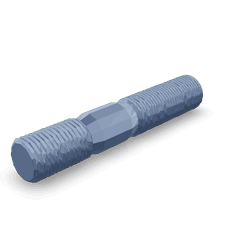4940753
Double End Plain Stud
Cummins®
IN STOCK

More than 10 are currently available
Ships within 1 business day
This truck part is made by Cummins®. We guarantee that all of our parts are from the OEM (original equipment manufacturer), ensuring a proper fit and quality manufacturing.
We honor the warranty provided by the original equipment manufacturer.
Introduction
The 4940753 Plain Hose Coupling, manufactured by Cummins, is a component designed for use in commercial trucks. It facilitates the connection of hoses in various fluid transfer systems, ensuring secure and leak-proof connections 1.
Basic Concepts of Plain Hose Couplings
Plain hose couplings are devices used to join two hoses or a hose to a fitting, allowing for the transfer of fluids such as coolant, fuel, or hydraulic fluid. They are integral to fluid transfer systems, providing a secure and leak-proof connection that can be easily assembled and disassembled as needed 2.
Purpose of the 4940753 Plain Hose Coupling
This Cummins part plays a role in the operation of a truck by connecting hoses and facilitating the transfer of fluids. It ensures that the connection is secure, minimizing the risk of leaks and ensuring efficient fluid flow throughout the system 3.
Key Features
The 4940753 Plain Hose Coupling features a straightforward design that includes a body, a clamp, and a gasket. The materials used in its construction are chosen for their durability and resistance to the fluids they will encounter. Its design allows for easy installation and removal, and it is built to withstand the rigors of commercial truck operations.
Benefits
This part offers several benefits, including ease of installation, which reduces downtime during maintenance. Its reliable design ensures consistent performance, and its efficiency in fluid transfer operations contributes to the overall effectiveness of the truck’s systems.
Installation Process
To install the 4940753 Plain Hose Coupling, first, ensure that the hoses are clean and free of debris. Slide the coupling onto one hose, then connect the other hose and secure it with the clamp. Tighten the clamp to the manufacturer’s specifications to ensure a secure fit without over-tightening, which could damage the hose or the coupling.
Troubleshooting Common Issues
Common issues with plain hose couplings include leaks and disconnections. To address leaks, check the clamp for proper tightness and ensure the gasket is in good condition. If disconnections occur, inspect the hoses for damage and ensure they are properly seated within the coupling.
Maintenance Tips
To maintain the 4940753 Plain Hose Coupling, perform regular inspections for signs of wear or damage. Clean the coupling and gasket as needed to remove any buildup that could affect performance. Replace the gasket if it shows signs of deterioration to maintain a secure seal.
Safety Considerations
When working with the 4940753 Plain Hose Coupling, follow safety practices such as wearing appropriate personal protective equipment. Ensure that the truck’s engine is off and that any pressurized systems are depressurized before beginning work. Handle the coupling and hoses carefully to avoid injury or damage.
Cummins: A Brief Overview
Cummins Inc. is a global power leader that designs, manufactures, and distributes engines, filtration, and power generation products. With a history of innovation and a broad product range, Cummins has established a strong reputation in the commercial truck industry for quality and reliability.
Role of Part 4940753 Plain Hose Coupling in Engine Systems
In the context of engine systems, the 4940753 Plain Hose Coupling is instrumental in ensuring the seamless operation of various components. When integrated with a spacer, the Plain Hose Coupling facilitates the proper alignment and connection between different sections of the engine’s fluid transfer systems. This alignment is essential for maintaining the integrity of fluid flow, whether it involves coolant, fuel, or other essential liquids.
Additionally, when paired with a fan pilot, the Plain Hose Coupling plays a significant role in the thermal management of the engine. The fan pilot, which controls the operation of the cooling fan, relies on consistent and reliable fluid transfer to function effectively. The Plain Hose Coupling ensures that the connections between the fan pilot and the associated hoses are secure and leak-free, thereby supporting the efficient dissipation of heat from the engine.
Overall, the integration of the Plain Hose Coupling with these components underscores its importance in maintaining the operational efficiency and reliability of engine systems.
Conclusion
The 4940753 Plain Hose Coupling by Cummins is a critical component in the maintenance and operation of commercial trucks. Its design ensures secure and leak-proof connections, contributing to the efficient transfer of fluids and the overall performance of the vehicle’s systems. Regular maintenance and proper installation are key to maximizing the benefits of this part.
-
Lakshminarayanan, P. A., & Agarwal, A. K. (2019). Design and Development of Heavy Duty Diesel Engines: A Handbook. Springer.
↩ -
Halderman, J. D. (2012). Automotive Principles: Diagnosis and Service. Prentice Hall.
↩ -
Fijalkowski, B. T. (2011). Automotive Mechatronics Operational and Practical Issues Volume 1. Springer.
↩
RECOMMENDED PARTS
* Variable geometry turbocharger and electronic actuator repairs are not eligible to be claimed as over-the-counter under New or ReCon parts warranty for parts installed after October 1, 2018.
* Diesel Oxidation Catalyst (DOC), Diesel Particulate Filter (DPF), Selective Catalyst Reduction (SCR) catalyst, and Electronic Control Module (ECM) repairs are not eligible to be claimed as over-the-counter under New or ReCon parts warranty for parts installed after January 1, 2020.
* These restrictions are only applicable to New parts and ReCon parts coverages for the components listed above sold to a customer in the US or Canada. All other coverages are excluded. All other regions are excluded.







